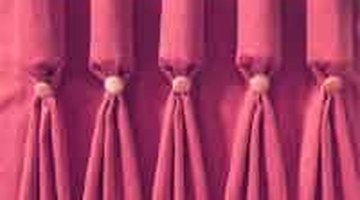How to Make Goblet Pleated Curtains
Goblet pleated curtains are considered to be among the more luxurious designs for window treatments. They are better suited for curtains that are both long enough to graze the floor and are fully lined to maintain their unique shape. The key to making attractive goblet curtains is to understand how to measure the fabric to create uniform "goblets" and pleats in even intervals. Once this is done, the rest is relatively easy. When selecting your fabric, choose a sturdy liner fabric at the same time. Keep in mind that the goblet pleating method of making curtain headers requires that the fabric to be used should be up to three times wider than the curtain rod from which they will hang. Before visiting your fabric store, measure from your curtain rod to the floor and add 1 or 2 inches. This will be the length of fabric that you will purchase. Next, measure the curtain rod itself. Multiply this number by 2.5 inches (or 3 inches, if you want larger goblet pleats). This number represents how wide your fabric should be. These are the only measurements that you will need before you begin. Once you start, the instructions below will show you how to measure for the pleats. This project can be completed in 1 to 3 days, depending on your experience, skill level and the size of your curtains.

-
Lay your primary fabric (outer side down) on a flat surface. Place the liner fabric on top. Fold the edges of the perimeter of the fabric so that a small seam is created. Use pins to hold the folded edges in place. Sew the edges to secure the seam, removing the pins as you go. When you reach the lower left and right corners, slip a curtain weight into the corner, and stitch around it to keep the weight stationary. This will help the curtain hang well.
-
Take the curtain's width measurement and divide it by 2. Subtract 2 inches to represent the width of the first pleat, and divide the resulting number into equal divisions of either 4 or 6 inches. This will give you the result that will tell you the number of pleats and their width. Mark the intervals with chalk.
-
Determine the space between each goblet pleat. Take the curtain's overall width measurement, divide it by 2, and subtract 2 inches from the result. Take this number and divide it by the number of pleats (from the previous step), minus 1.
-
Take your chalk and use it with your tape measure to mark your curtain 2 inches from the top left edge. From here, mark the width of the first pleat, then the width of each gap, alternately, along the entire length of the top of the curtain. Make sure that you leave a flat area 2 inches in from the top right edge.
-
Create the first goblet pleat by smoothing the fabric on your work surface. Insert two fingers beneath the top edge of the curtain and lift it up creating a cylindrical "cup" formation at least 2 inches in diameter and 3 to 5 inches long/deep. Pinch the fabric tightly beneath the cup with the other hand, forming three vertical pleats beneath the cup or "goblet." Secure with a pin. Stuff a bit of fiberfill or batting material into the goblet to maintain its shape. Note the flat area or gap that follows this first goblet, smooth it with your hand and move to the next section to be goblet pleated. Repeat along the entire length of curtain to complete the header. Reshape and re-pin the pleats as necessary until you are satisfied with their appearance.
-
Use your sewing machine to securely stitch the pinned areas beneath each goblet. A fabric-covered button or other embellishment can be fastened just below the goblet if you wish. Remove any pins once the stitching is complete. Allow the goblets to remain stuffed with fiberfill/batting material so that they won't lose their shape. Wipe away any remaining chalk marks. Attach curtain hooks to the rear of the curtain and hang them from the curtain rod.
Tips
- Take measurements at least twice to be certain that your dimensions are correct. Write them down so that you don't forget or mix them up.
Warnings
- Avoid rushing Step 5. Even, uniform spacing of the goblet pleats is every bit as important as taking correct fabric measurements.
Writer Bio
Genae Valecia Hinesman, former banking executive, entrepreneur and fashion model, began writing professionally in 2002. She is a Cum Laude graduate of the University of Southern California where she studied business, finance and exercise physiology. Her articles featured in Living Healthy: 360, Life 123, the American Chronicle and Yahoo Voices.
Photo Credits
- Alternative Windows
More Articles



